Measuring the Performance of Industrial Green Development Using a Non-Radial Directional Distance Function Approach: A Case Study of Jiangxi Province in China
Abstract
:1. Introduction
- (1)
- What is the overall situation and dynamic change of the PIGD for Jiangxi Province? Are there obvious regional differences? Which one of the two decomposition indices of the PIGD is the main driver of the growth of the PIGD?
- (2)
- What are the effective strategies for raising the PIGD?
2. Materials and Methods
2.1. Global Non-Radial Directional Distance Function (GNDDF)
2.2. Data
2.2.1. Input Indicators
2.2.2. Output Indicators
2.3. Influencing Factors
- (1)
- We selected per capita GDP (PGDP) to represent the level of economic development in the city of interest. In general, a greater PGDP makes sustainable development of the industrial economy more likely. This is because a city with a relatively higher PGDP pays more attention to the quality of industrial economic development, and does not focus solely on the scale of the industrial economy [30]. Therefore, we assume a positive correlation between PGDP and PIGD; an increase in the PGDP is expected to have a positive impact on the PIGD.
- (2)
- We selected energy structure (ES), referring to the share of coal in the total energy consumption used for industrial production, to represent the status of industrial energy consumption. It is generally accepted that coal combustion produces significantly more pollutants than many other types of energy sources, and substituting clean energy for coal promotes protection of the ecological environment [31]. According to the China Energy Statistics Yearbook, coal accounted for more than 90% of industrial energy consumption in Jiangxi Province in recent decades; such a state of affairs is clearly not conducive to sustainable industrial development. We assume that decreasing the share of coal in the total energy consumption used for industrial production contributes to improving the PIGD; an increase in the ES is thus assumed to have a negative impact on the PIGD.
- (3)
- We selected investment in environmental pollution management (INV) to represent the government’s regulation of industrial pollution. This is because many previous studies have found that the government’s investment in environmental management plays an important role in preventing industrial pollution [32,33]. A possible reason is that more investment in environmental protection technology and management may positively affect sustainable industrial development through energy savings and the reduction of industrial pollutants [34,35]. In fact, the investment in environmental pollution management was formally established in 1980s, and the management of industrial pollution is one of its important goals, e.g., the management of industrial pollution sources and reuse of industrial wastewater. The environmental pollution control work in China has always been initiated by the central government and operated by local governments, and the local governments are expected to use the environmental pollution control investment effectively by quickly identifying and dealing with local pollution incidents [36]. Therefore, we assume that an increase in investment in environmental management has a positive impact on the PIGD.
- (4)
- We selected two indices—the share of industrial labor in the total labor (LS) and the share of industrial GDP in the total GDP (IS)—to represent the current industrial structure. The problem of surplus labor in the industrial sector is common in China, and Jiangxi is no exception. Most industrial enterprises are labor-intensive and engaged in low-tech production activities because of cheap labor. This inevitably impedes the large-scale use of new technologies and industrial upgrading, and negatively affects the PIGD [37]. Further, many studies suggested that China had entered a middle or late stage of industrialization, which implyies that China’s industrial development will shift from a simple emphasis on economic output to improvements in the quality of industrial development [38]. This might lead to a reduction of the IS. Thus, we assume that an increase in both the LS and IS has a negative impact on the PIGD.
3. Results and Discussion
3.1. The PIGD and Its Decomposition Indicators
3.2. Spatio-Temporal Pattern of PIGD and Its Decomposition Indicators
3.3. Optimization of the PIGD
3.4. Influencing Factor Analysis
4. Conclusions
Acknowledgments
Author Contributions
Conflicts of Interest
Appendix A
| Variables | (1) | (2) | Conclusion | ||||||
|---|---|---|---|---|---|---|---|---|---|
| LLC | IPS | ADF-Fisher | PP-Fisher | ||||||
| Statistic | Prob. | Statistic | Prob. | Statistic | Prob. | Statistic | Prob. | ||
| PIGD | −9.505 | 0.000 *** | −8.082 | 0.000 *** | 94.470 | 0.000 *** | 96.814 | 0.000 *** | Stationary |
| lnPGDP | −3.989 | 0.000 *** | −2.749 | 0.001 *** | 38.414 | 0.002 *** | 38.283 | 0.001 *** | Stationary |
| ES | −11.354 | 0.000 *** | −7.544 | 0.000 *** | 89.328 | 0.000 *** | 90.046 | 0.000 *** | Stationary |
| lnINV | −9.711 | 0.000 *** | −6.312 | 0.000 *** | 76.856 | 0.000 *** | 86.463 | 0.000 *** | Stationary |
| IS | −4.347 | 0.000 *** | −2.832 | 0.002 *** | 40.314 | 0.002 *** | 39.424 | 0.002 *** | Stationary |
| LS | −5.233 | 0.000 *** | −3.430 | 0.000 *** | 46.474 | 0.001 *** | 47.682 | 0.001 *** | Stationary |
References
- Zhou, Y.; Lu, Y.; Xie, J.; Feng, C. Analysis on the factors of out-oriented economy in the western China. Econ. Geogr. 2006, 26, 207–211. (In Chinese) [Google Scholar]
- Liu, X.T. On Industrial Cluster Development of Industrial Parks: A Case Study of Jiangxi Province in China. Appl. Mech. Mater. 2011, 55, 2003–2008. [Google Scholar] [CrossRef]
- Shi, X.; Heerink, N.; Qu, F. Does off-farm employment contribute to agriculture-based environmental pollution? New insights from a village-level analysis in Jiangxi Province, China. China Econ. Rev. 2011, 22, 524–533. [Google Scholar] [CrossRef]
- Yu, Y.; Li, Q.; Wang, H.; Wang, B.; Lu, Q.; Yan, Z.; Ding, A. Exposure risk of young population to lead: A case study in Le’an River Basin in Jiangxi Province, China. Environ. Pollut. 2015, 209, 140–145. [Google Scholar] [CrossRef] [PubMed]
- Teng, Y.; Li, J.; Wu, J.; Lu, S.; Wang, Y.; Chen, H. Environmental distribution and associated human health risk due to trace elements and organic compounds in soil in Jiangxi province, China. Ecotoxicol. Environ. Saf. 2015, 155, 406–416. [Google Scholar] [CrossRef] [PubMed]
- Albrizio, S.; Kozluk, T.; Zipperer, V. Environmental policies and productivity growth: Evidence across industries and firms. J. Environ. Econ. Manag. 2017, 81, 209–226. [Google Scholar] [CrossRef]
- Yi, H.; Liu, Y. Green economy in China: Regional variations and policy drivers. Glob. Environ. Chang. 2015, 31, 11–19. [Google Scholar] [CrossRef]
- Chen, S.; Golley, J. ‘Green’ productivity growth in China's industrial economy. Energy Econ. 2014, 44, 89–98. [Google Scholar] [CrossRef]
- Xie, H.; Yu, Y.; Wang, W.; Liu, Y. The substitutability of non-fossil energy, potential carbon emission reduction and energy shadow prices in China. Energy Policy 2017, 107, 63–71. [Google Scholar] [CrossRef]
- Xie, H.; Wang, W.; Yang, Z.; Choi, Y. Measuring the sustainable performance of industrial land utilization in major industrial zones of China. Technol. Forecast. Soc. Chang. 2016, 112, 207–219. [Google Scholar] [CrossRef]
- Wang, W.; Xie, H.; Jiang, T.; Zhang, D.; Xie, X. Measuring the total-factor carbon emission performance of industrial land use in China based on the global directional distance function and non-radial Luenberger productivity index. Sustainability 2016, 8, 336. [Google Scholar] [CrossRef]
- Liu, G.; Tao, L.; Liu, X.; Hou, J.; Wang, A.; Li, R. Heavy metal speciation and pollution of agricultural soils along Jishui River in non-ferrous metal mine area in Jiangxi Province, China. J. Geochem. Explor. 2013, 132, 156–163. [Google Scholar] [CrossRef]
- Yao, G.; Xie, H. Rural spatial restructuring in ecologically fragile mountainous areas of southern China: A case study of Changgang Town, Jiangxi Province. J. Rural Stud. 2016, 47, 435–448. [Google Scholar] [CrossRef]
- Kirchner, M.; Schmid, E. Integrated regional impact assessment of agricultural trade and domestic environmental policies. Land Use Policy 2013, 35, 359–378. [Google Scholar] [CrossRef]
- Cheng, J.; Dai, S.; Ye, X. Spatiotemporal heterogeneity of industrial pollution in China. China Econ. Rev. 2016, 40, 179–191. [Google Scholar] [CrossRef]
- Xie, H.; Wang, W. Exploring the spatial-temporal disparities of urban land use economic efficiency in China and its influencing factors under environmental constraints based on a sequential slacks-based model. Sustainability 2015, 7, 10171–10190. [Google Scholar] [CrossRef]
- Charnes, A.; Cooper, W.W.; Rhodes, E. Measuring the efficiency of decision making units. Eur. J. Oper. Res. 1978, 2, 429–444. [Google Scholar] [CrossRef]
- Zhang, N.; Choi, Y. A note on the evolution of directional distance function and its development in energy and environmental studies 1997–2013. Renew. Sustain. Energy Rev. 2014, 33, 50–59. [Google Scholar] [CrossRef]
- He, W.; Wu, K. Regional industrial competitiveness evaluation: An empirical analysis based on 11 cities in Jiangxi province. Sci.-Technol. Manag. 2013, 5, 67–71. (In Chinese) [Google Scholar]
- Zhou, G.; Guo, Y.; Long, Q. The orientation and path choice of Jiangxi Industrial Park transformation and upgrading. Jiangxi Soc. Sci. 2016, 2, 56–60. (In Chinese) [Google Scholar]
- Huang, H.; Wang, L. A Study of the evolution of regional industrial environment technical efficiency and environmental coordination in Jiangxi province from the perspective of environmental constraints. J. Jiangxi Univ. Financ. Econ. 2016, 5, 98–105. (In Chinese) [Google Scholar]
- Zhou, P.; Poh, K.L.; Ang, B.W. A non-radial DEA approach to measuring environmental performance. Eur. J. Oper. Res. 2007, 178, 1–9. [Google Scholar] [CrossRef]
- Krivonozhko, V.E.; Førsund, F.R.; Lychev, A.V. Measurement of returns to scale using non-radial DEA models. Eur. J. Oper. Res. 2014, 232, 664–670. [Google Scholar] [CrossRef]
- Zhang, C.; Chen, Z. Sustainability characteristics of China’s Poyang Lake Eco-Economics Zone in the big data environment. J. Clean. Prod. 2017, 142, 642–653. [Google Scholar] [CrossRef]
- Chambers, R.G.; Chung, Y.; Färe, R. Benefit and distance functions. J. Econ. Theory 1996, 70, 407–419. [Google Scholar] [CrossRef]
- Zhang, N.; Kim, J.D. Measuring sustainability by Energy Efficiency Analysis for Korean Power Companies: A Sequential Slacks-Based Efficiency Measure. Sustainability 2014, 6, 1414–1426. [Google Scholar] [CrossRef]
- Wu, Y. Export performance in China’s regional economies. Appl. Econ. 2007, 39, 1283–1293. [Google Scholar] [CrossRef]
- Ederer, N. Evaluating capital and operating cost efficiency of offshore wind farms: A DEA approach. Renew. Sustain. Energy Rev. 2015, 42, 1034–1046. [Google Scholar] [CrossRef]
- Liu, J.; Zhang, J.; Fu, Z. Tourism eco-efficiency of Chinese coastal cities—Analysis based on the DEA-Tobit model. Ocean Coast. Manag. 2017, 148, 164–170. [Google Scholar] [CrossRef]
- Andreano, M.S.; Laureti, L.; Postiglione, P. Economic growth in MENA countries: Is there convergence of per-capita GDPs? J. Policy Model. 2013, 35, 669–683. [Google Scholar] [CrossRef]
- Yu, S.; Wei, Y. Prediction of China’s coal production-environmental pollution based on a hybrid genetic algorithm-system dynamics model. Energy Policy 2012, 42, 521–529. [Google Scholar] [CrossRef]
- Che, W. Investment for environmental conservation in China mainland at provincal level. Econ. Geogr. 2009, 29, 237–243. (In Chinese) [Google Scholar]
- Yan, W. Fiscal Decentralization, Government Competition and Environmental Pollution Disposal Investment. Financ. Trade Res. 2012, 5, 91–97. (In Chinese) [Google Scholar]
- Lan, J.; Kakinaka, M.; Huang, X. Foreign Direct Investment, Human Capital and Environmental Pollution in China. Environ. Resour. Econ. 2012, 51, 255–275. [Google Scholar] [CrossRef]
- Cai, X.; Lu, Y.; Wu, M.; Yu, L. Does environmental regulation drive away inbound foreign direct investment? Evidence from a quasi-natural experiment in China. J. Dev. Econ. 2016, 123, 73–85. [Google Scholar] [CrossRef]
- Zhu, H.; Fu, Q.; Wei, Q. Calculation of Efficiency on Environmental Expenditure and Study on Influential Factors. China Popul. Resour. Environ. 2014, 24, 91–96. (In Chinese) [Google Scholar]
- Xie, H.; Wang, W. Spatiotemporal differences and convergence of urban industrial land use efficiency for China’s major economic zones. J. Geogr. Sci. 2015, 25, 1183–1198. [Google Scholar] [CrossRef]
- Jiang, G.; He, X.; Qu, Y.; Zhang, R.; Meng, Y. Functional evolution of rural housing land: A comparative analysis across four typical areas representing different stages of industrialization in China. Land Use Policy 2016, 57, 645–654. [Google Scholar] [CrossRef]
- Ozkan, N.F.; Ulutas, B.H. Efficiency analysis of cement manufacturing facilities in Turkey considering undesirable outputs. J. Clean. Prod. 2017, 156, 932–938. [Google Scholar] [CrossRef]
- Wu, C.H.; Ding, C.G.; Jane, T.D.; Lin, H.R.; Wu, C.Y. Lessons from the global financial crisis for the semiconductor industry. Technol. Forecast. Soc. Chang. 2015, 99, 47–53. [Google Scholar] [CrossRef]
- Zhang, N.; Xie, H. Toward green IT: Modeling sustainable production characteristics for Chinese electronic information industry, 1980–2012. Technol. Forecast. Soc. Chang. 2015, 96, 62–70. [Google Scholar] [CrossRef]
- Wan, L.; Zhang, Y.; Qi, S.; Li, H.; Chen, X.; Zang, S. A study of regional sustainable development based on GIS/RS and SD model—Case of Hadaqi industrial corridor. J. Clean. Prod. 2017, 142, 654–662. [Google Scholar] [CrossRef]
- Jiangxi Provincial Bureau of Statistics. Jiangxi Statistical Yearbook; China Statistics Press: Beijing, China, 2016. (In Chinese) [Google Scholar]
- Du, Q.; Wang, Y.; Ren, F.; Zhao, Z.; Liu, H.; Wu, C.; Li, L.; Shen, Y. Measuring and Analysis of Urban Competitiveness of Chinese Provincial Capitals in 2010 under the Constraints of Major Function-Oriented Zoning Utilizing Spatial Analysis. Sustainability 2014, 6, 3374–3399. [Google Scholar] [CrossRef]
- Wang, X.; Dong, X. On the development of circular economy in the process of industrialization in Jiangxi. Jiangxi Soc. Sci. 2007, 1, 254–256. (In Chinese) [Google Scholar]
- Tobin, J. Estimation of relationships for limited dependent variables. Econometrica 1958, 26, 24–36. [Google Scholar] [CrossRef]
- Niu, D.; Song, Z.; Xiao, X.; Wang, Y. Analysis of wind turbine micrositing efficiency: An application of two-subprocess data envelopment analysis method. J. Clean. Prod. 2018, 170, 193–204. [Google Scholar] [CrossRef]
- Levin, A.; Lin, C.F.; Chu, C.S.J. Unit root tests in panel data: Asymptotic and finite sample properties. J. Econom. 2002, 108, 1–24. [Google Scholar] [CrossRef]
- Im, K.S.; Pesaran, M.H.; Shin, Y. Testing for unit roots in heterogeneous panels. J. Econom. 2003, 108, 53–74. [Google Scholar] [CrossRef]
- Zhou, Y.; Zhu, S.; He, C. How do environmental regulations affect industrial dynamics? Evidence from China’s pollution-intensive industries. Habit Int. 2017, 60, 10–18. [Google Scholar] [CrossRef]
- Eyraud, L.; Clements, B.; Wane, A. Green investment: Trends and determinants. Energy Policy 2013, 60, 852–865. [Google Scholar] [CrossRef]
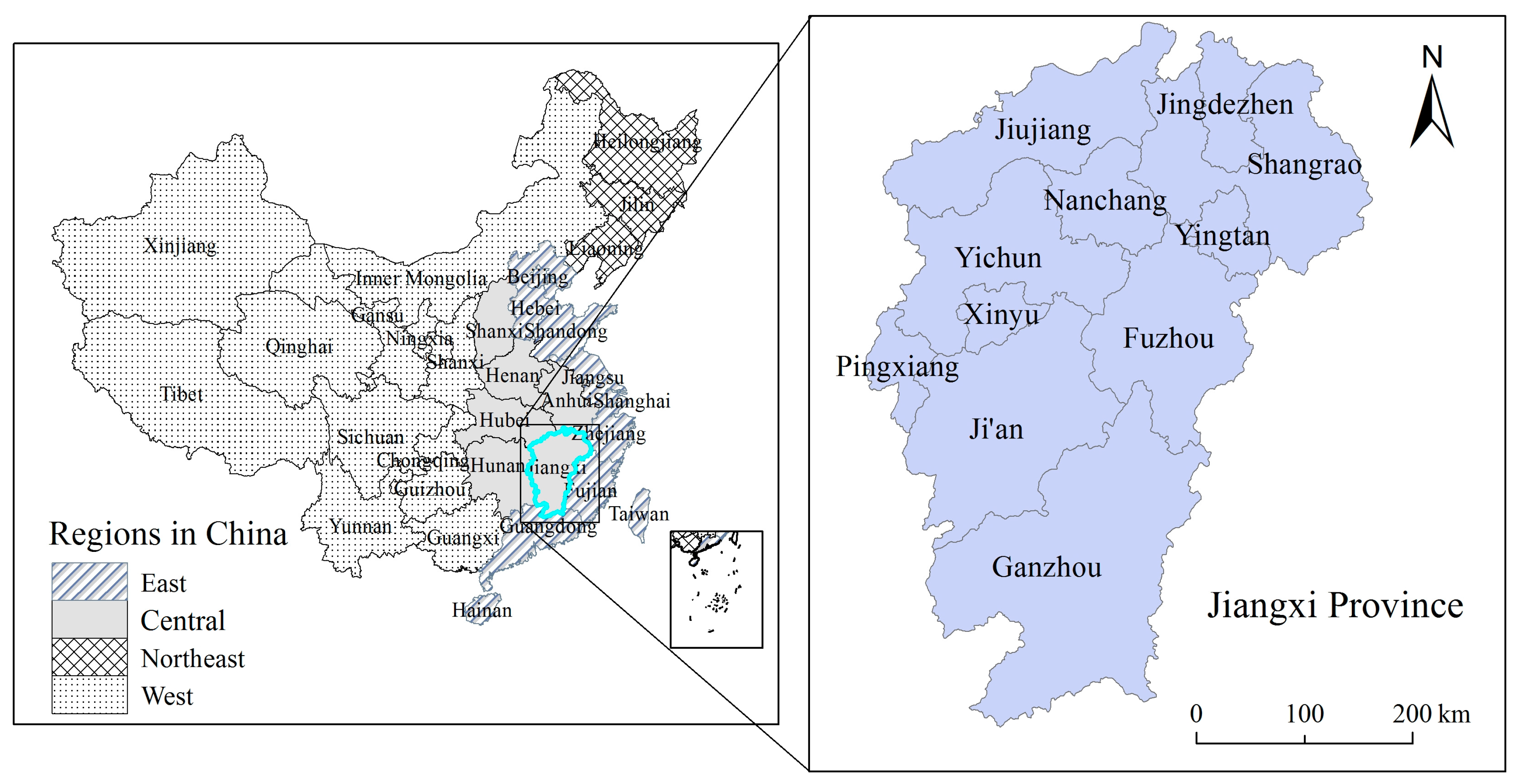
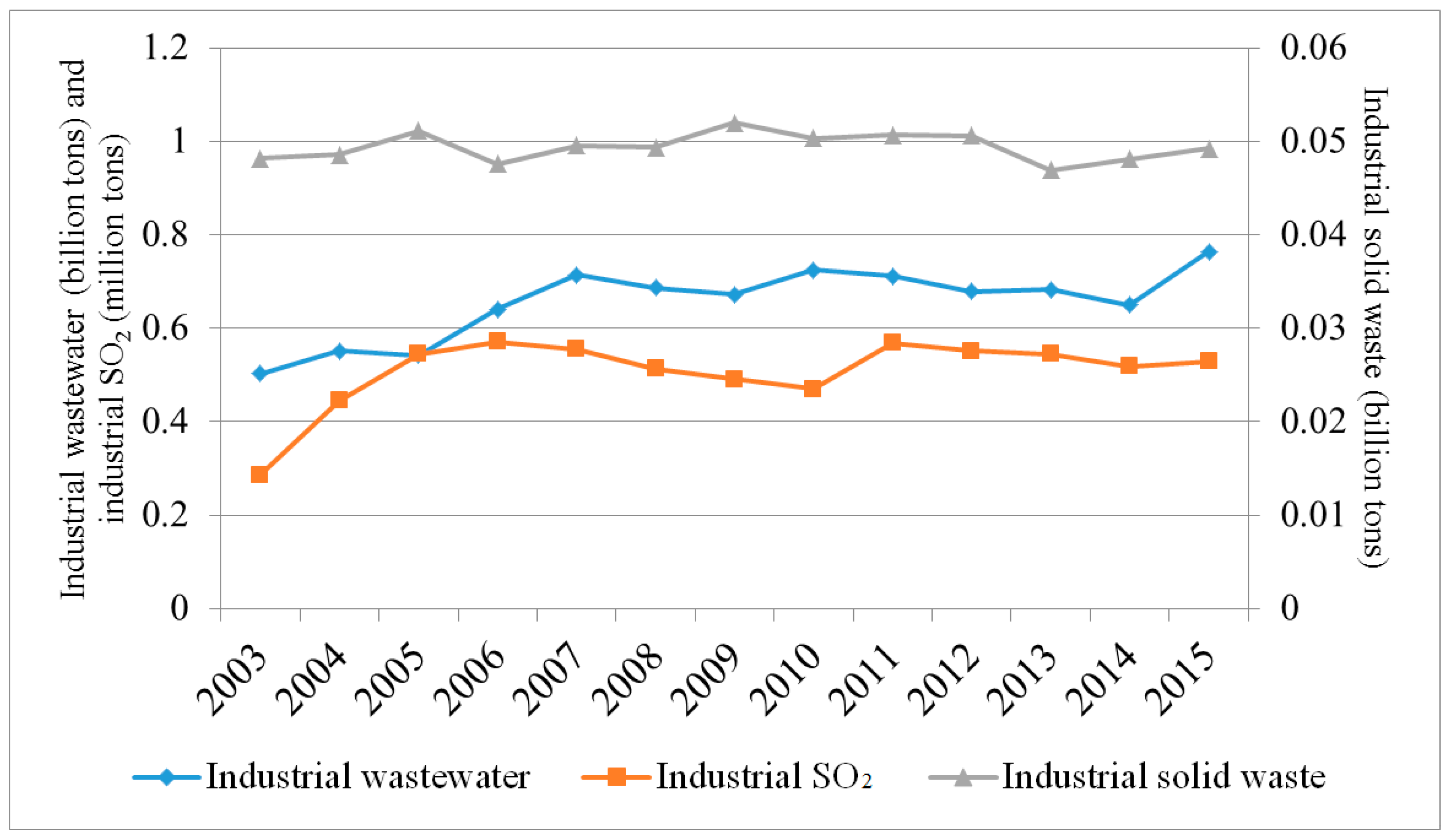
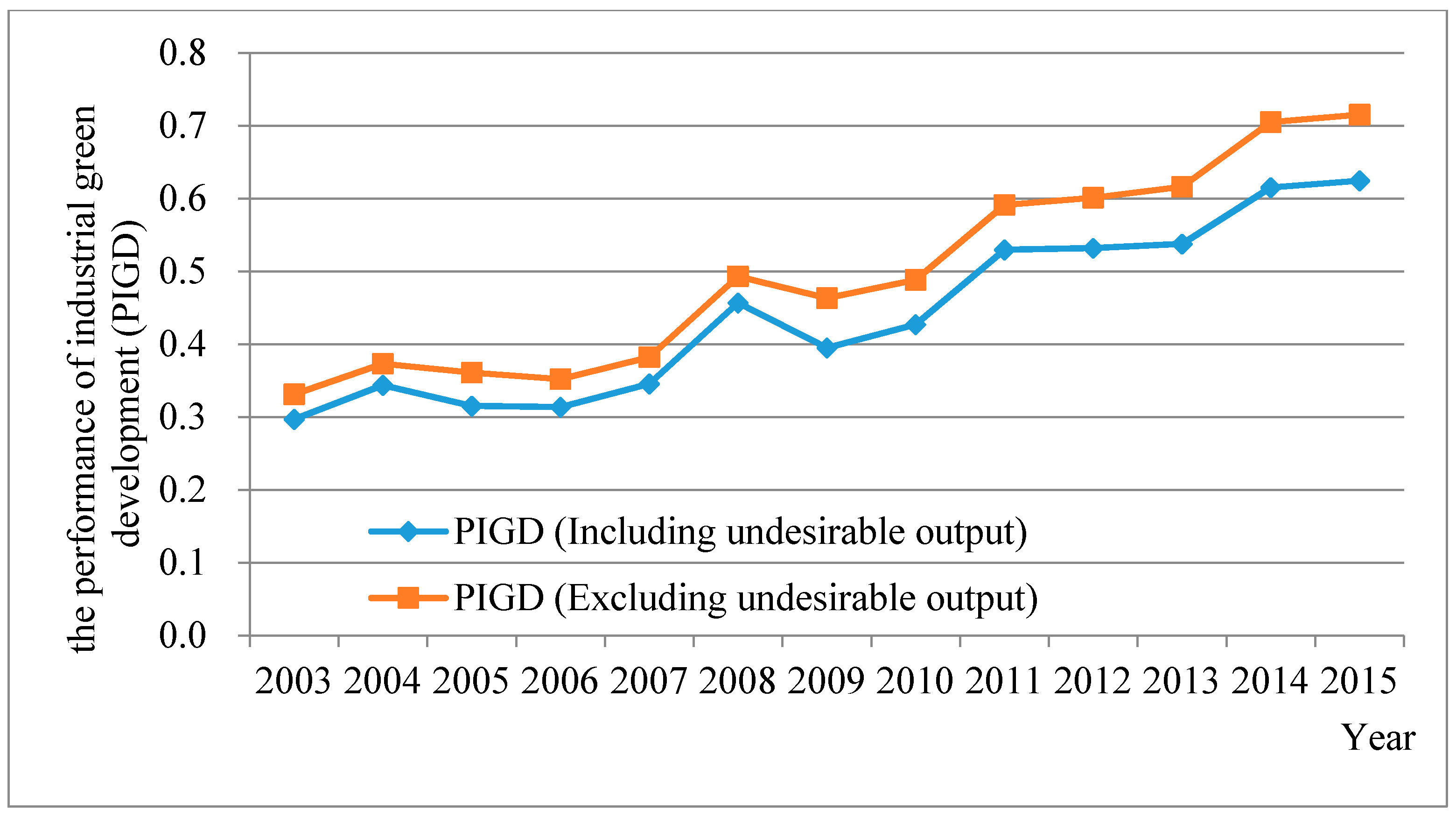
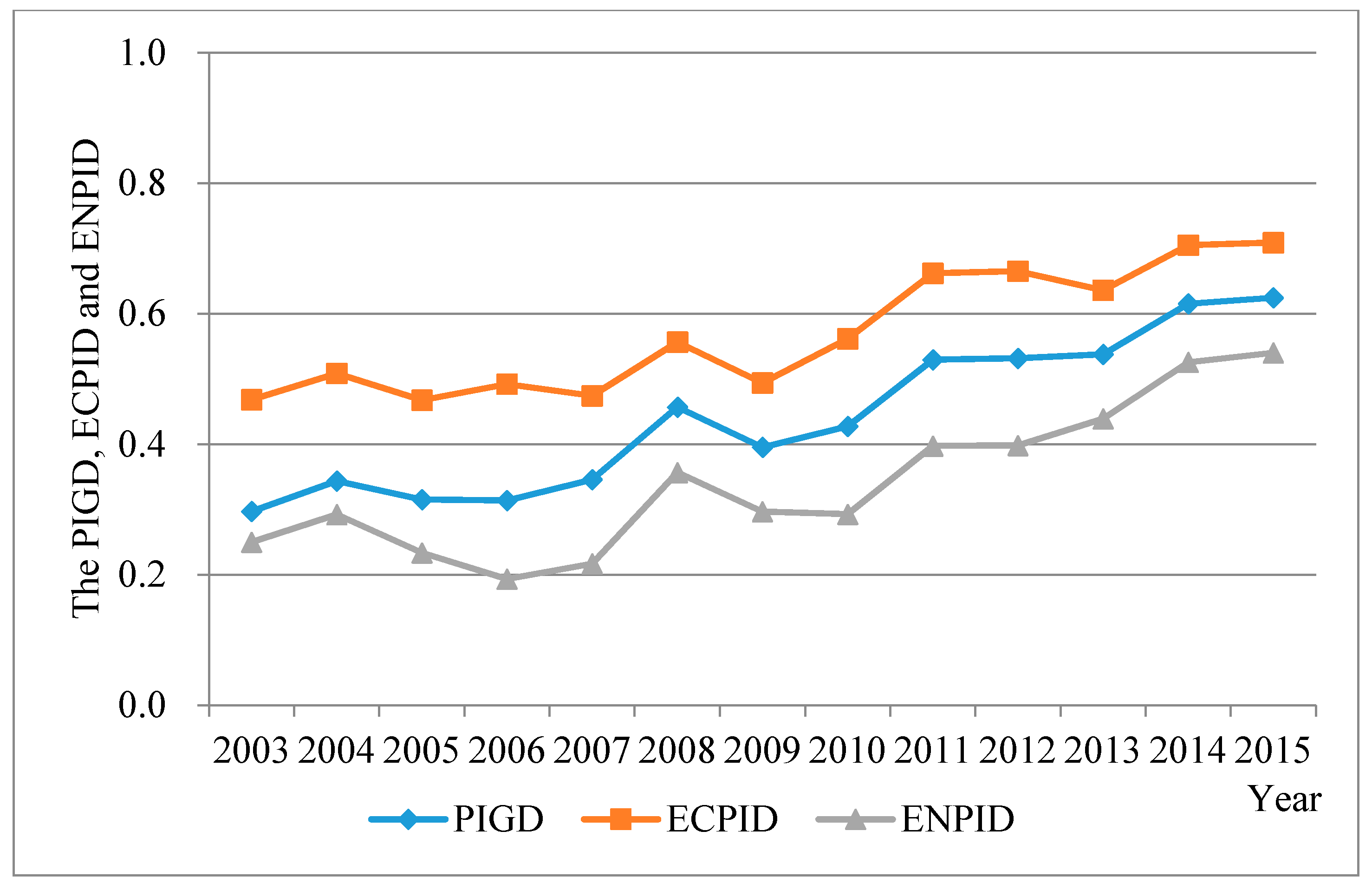
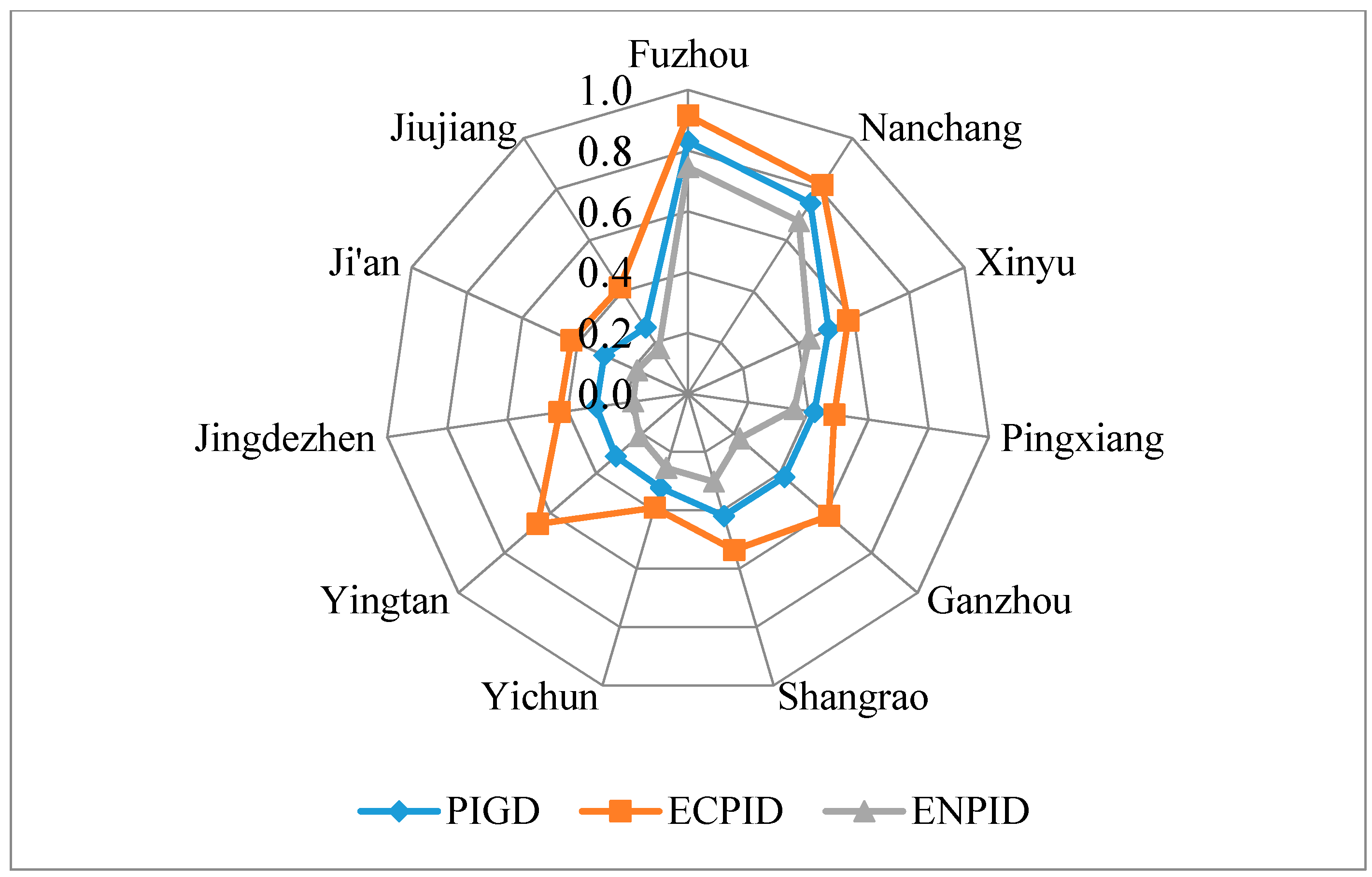

| Type of Variable | Variable | Unit | Max. | Min. | Mean | St. Dev. |
|---|---|---|---|---|---|---|
| Input | Energy | 104 ton | 1209.67 | 13.06 | 410.21 | 277.19 |
| Capital | 108 yuan | 1596.61 | 24.90 | 358.12 | 325.95 | |
| Labor | 104 people | 177.40 | 11.90 | 64.75 | 40.79 | |
| Desirable output | GDP | 108 yuan | 2179.96 | 37.83 | 428.22 | 375.08 |
| Undesirable output | Industrial wastewater | 108 ton | 1.68 | 0.14 | 0.60 | 0.30 |
| Industrial SO2 | 104 ton | 10.25 | 1.34 | 4.59 | 2.26 | |
| Industrial solid waste | 104 ton | 4270.76 | 0.37 | 346.03 | 1018.14 |
| Variable | Unit | Max. | Min. | Mean | St. Dev. |
|---|---|---|---|---|---|
| PGDP | 104 yuan | 2.10 | -0.90 | 0.60 | 0.74 |
| ES | — | 1.00 | 0.48 | 0.94 | 0.14 |
| INV | 104 yuan | 3.24 | -3.91 | 0.73 | 1.38 |
| IS | — | 0.67 | 0.33 | 0.52 | 0.08 |
| LS | — | 0.64 | 0.19 | 0.43 | 0.11 |
| Inputs Excess (%) | Desirable Output Shortage (%) | Undesirable Output Excess (%) | |||||
|---|---|---|---|---|---|---|---|
| Energy | Capital | Labor | GDP | Wastewater | SO2 | Solid Waste | |
| Nanchang | 27.99 | 2.25 | 17.48 | 0.00 | 30.20 | 20.32 | 43.35 |
| Jingdezhen | 75.16 | 41.89 | 56.82 | 62.04 | 73.81 | 86.80 | 84.46 |
| Pingxiang | 76.87 | 24.23 | 55.91 | 16.19 | 16.83 | 75.89 | 83.69 |
| Jiujiang | 64.98 | 18.71 | 27.72 | 80.87 | 40.17 | 58.16 | 42.21 |
| Xinyu | 57.18 | 27.46 | 33.57 | 21.14 | 49.47 | 54.84 | 62.32 |
| Yingtan | 65.66 | 24.87 | 8.53 | 51.95 | 69.61 | 66.69 | 88.39 |
| Ganzhou | 32.70 | 2.21 | 78.68 | 12.75 | 67.98 | 70.57 | 88.34 |
| Jian | 61.94 | 39.28 | 67.22 | 55.46 | 77.48 | 87.26 | 86.01 |
| Yichun | 81.54 | 30.94 | 68.61 | 50.10 | 46.38 | 69.18 | 85.90 |
| Fuzhou | 0.98 | 8.55 | 21.21 | 0.00 | 26.27 | 30.70 | 24.98 |
| Shangrao | 55.98 | 19.29 | 75.24 | 31.03 | 49.05 | 63.43 | 89.94 |
| Jiangxi Province | 62.51 | 20.92 | 52.03 | 29.15 | 48.30 | 56.31 | 75.42 |
| Dependent Variable: PIGD | |||||
|---|---|---|---|---|---|
| (1) | (2) | (3) | (4) | (5) | |
| lnPGDP | 0.1475 *** | 0.1456 *** | 0.1954 *** | 0.2641 *** | 0.2361 *** |
| (5.7529) | (5.7646) | (6.4144) | (9.3551) | (7.0675) | |
| ES | −0.2871 ** | −0.2648 ** | −0.2291 * | −0.2186 * | |
| (−2.1538) | (−2.0355) | (−1.8085) | (−1.8569) | ||
| lnINV | −0.0454 *** | −0.0582 *** | −0.0563 *** | ||
| (−2.7738) | (−3.9435) | (−3.8008) | |||
| IS | −2.0174 *** | −2.0249 *** | |||
| (−6.0556) | (−6.0986) | ||||
| LS | −0.2453 | ||||
| (−1.0168) | |||||
| Constant | 0.3529 *** | 0.0852 | 0.1094 | 1.1367 *** | 1.0323 *** |
| (14.4801) | (0.6736) | (0.8853) | (5.6181) | (4.5636) | |
| Adjusted R2 | 0.2931 | 0.3177 | 0.3582 | 0.4121 | 0.4153 |
| Prob. | 0.0000 | 0.0000 | 0.0000 | 0.0000 | 0.0000 |
| Hausman test | 0.48 | 1.05 | 2.19 | 6.76 | 6.96 |
| Hausman test Prob. | 0.7855 | 0.7901 | 0.7003 | 0.2389 | 0.3244 |
© 2017 by the authors. Licensee MDPI, Basel, Switzerland. This article is an open access article distributed under the terms and conditions of the Creative Commons Attribution (CC BY) license (http://creativecommons.org/licenses/by/4.0/).
Share and Cite
Wang, W.; Xie, H.; Lu, F.; Zhang, X. Measuring the Performance of Industrial Green Development Using a Non-Radial Directional Distance Function Approach: A Case Study of Jiangxi Province in China. Sustainability 2017, 9, 1757. https://doi.org/10.3390/su9101757
Wang W, Xie H, Lu F, Zhang X. Measuring the Performance of Industrial Green Development Using a Non-Radial Directional Distance Function Approach: A Case Study of Jiangxi Province in China. Sustainability. 2017; 9(10):1757. https://doi.org/10.3390/su9101757
Chicago/Turabian StyleWang, Wei, Hualin Xie, Fucai Lu, and Xinmin Zhang. 2017. "Measuring the Performance of Industrial Green Development Using a Non-Radial Directional Distance Function Approach: A Case Study of Jiangxi Province in China" Sustainability 9, no. 10: 1757. https://doi.org/10.3390/su9101757





